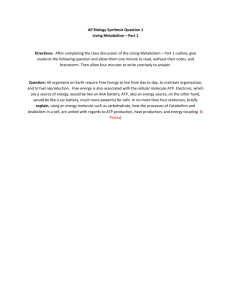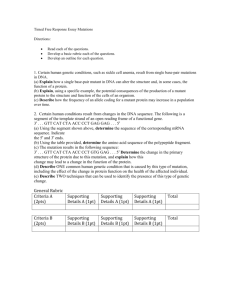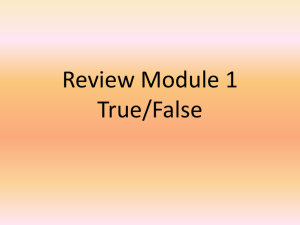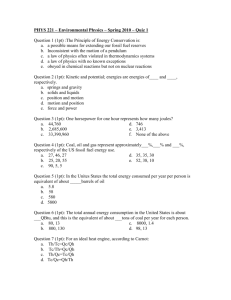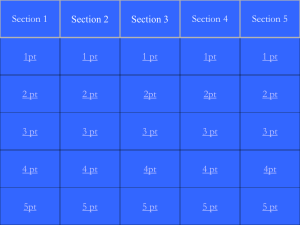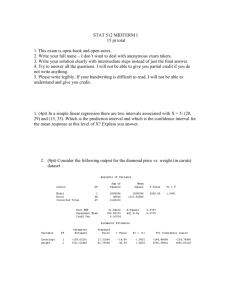King Fahd University of Petroleum & Minerals
advertisement
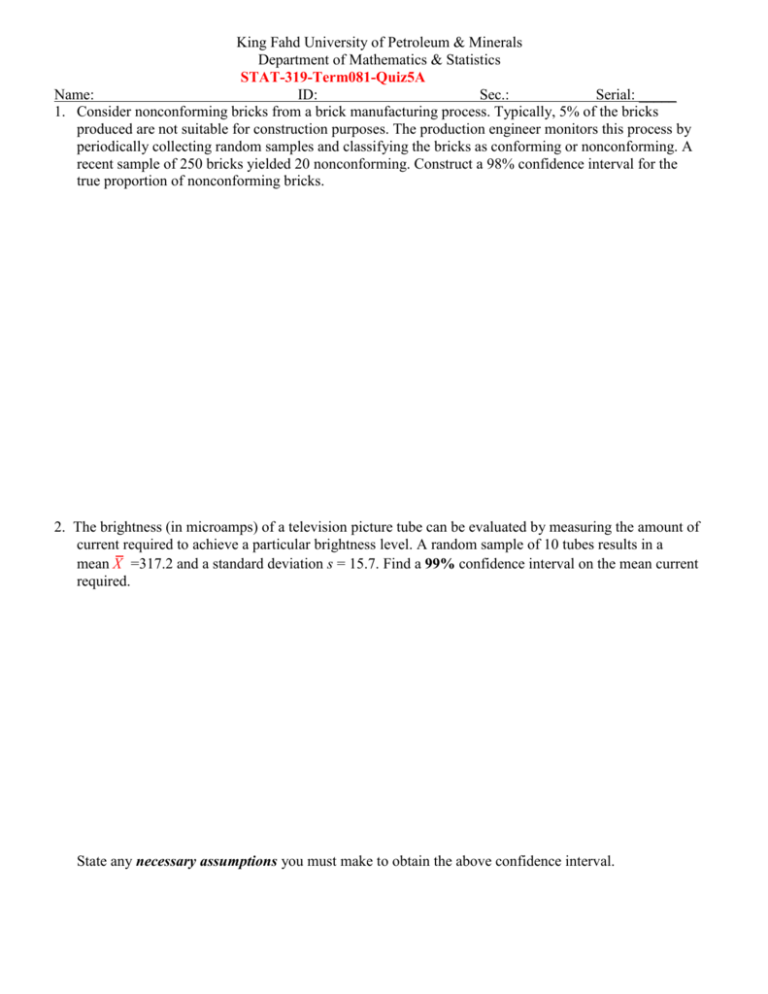
King Fahd University of Petroleum & Minerals Department of Mathematics & Statistics STAT-319-Term081-Quiz5A-SOLUTIONS Name: ID: Sec.: Serial: _____ 1. Consider nonconforming bricks from a brick manufacturing process. Typically, 5% of the bricks produced are not suitable for construction purposes. The production engineer monitors this process by periodically collecting random samples and classifying the bricks as conforming or nonconforming. A recent sample of 250 bricks yielded 20 nonconforming. Construct a 98% confidence interval for the true proportion of nonconforming bricks. 98% C.I 0.98 = 1 - =0.02. So, /2 = 0.01. (1pt) p x / n = 20/250 = 0.08 (1pt) 98% CI for p: p Z /2 p(1 p) n . (1pt) 0.08(1 0.08) 0.08 2.33 250 = 0.08 + 2.33(0.017158) (1pt) = 0.08 + 0.039978 =(0.040022, 0.119978) Interpret: We are 98% confident that the true proportion of nonconforming bricks is between 0.040022 and 0.119978 (1pt) 2. The brightness (in microamps) of a television picture tube can be evaluated by measuring the amount of current required to achieve a particular brightness level. A random sample of 10 tubes results in a mean X =317.2 and a standard deviation s = 15.7. Find a 99% confidence interval on the mean current required. n =10 x =?. population x = unknown and small samples. So use t with df = n-1 = 10-1 = 9 (1pt) 99% C.I 0.99 = 1 - =0.01. So, /2 = 0.005. t/2 .= t0.005 = 3.25 from t table (column = 0.05, row =df=9) (1pt) 99% CI for : s x t /2 n . (1pt) 15.7 317.2 3.25 10 = 317.2 + 3.25(4.964781) = 317.2 + 16.1355 =(301.0645, 333.3355) Interpret: We are 99% confident that the true mean of required current is between 301.0645 and 333.3355. (1pt) State any necessary assumptions you must make to obtain the above confidence interval. X must be from a normal population (1pt) = 10 + 5 (4) =30 King Fahd University of Petroleum & Minerals Department of Mathematics & Statistics STAT-319-Term081-Quiz5B-SOLUTIONS Name: ID: Sec.: Serial: _____ 1. Consider nonconforming bricks from a brick manufacturing process. Typically, 5% of the bricks produced are not suitable for construction purposes. The production engineer monitors this process by periodically collecting random samples and classifying the bricks as conforming or nonconforming. A recent sample of 300 bricks yielded 24 nonconforming. Construct a 96% confidence interval for the true proportion of nonconforming bricks. 96% C.I 0.96 = 1 - =0.04. So, /2 = 0.02. (1pt) p x / n = 24/300 = 0.08 (1pt) 96% CI for p: p Z /2 p(1 p) n . (1pt) 0.08(1 0.08) 300 = 0.08 + 2.05(0.015663) (1pt) = 0.08 + 0.032109 =(0.047891, 0.112109) Interpret: We are 96% confident that the true proportion of nonconforming bricks is between 0.047891 and 0.112109 (1pt) 0.08 2.05 2. The brightness (in microamps) of a television picture tube can be evaluated by measuring the amount of current required to achieve a particular brightness level. A random sample of 10 tubes results in a mean X =327.2 and a standard deviation s = 15.7. Find a 95% confidence interval on the mean current required. n =10 x =?. population x = unknown and small samples. So use t with df = n-1 = 10-1 = 9 (1pt) 99% C.I 0.99 = 1 - =0.01. So, /2 = 0.005. t/2 .= t0.005 = 3.25 from t table (column = 0.05, row =df=9) (1pt) 99% CI for : s x t /2 n . (1pt) 15.7 327.2 3.25 10 = 327.2 + 3.25(4.964781) = 327.2 + 16.1355 =(311.0645, 343.3355) Interpret: We are 99% confident that the true mean of required current is between 311.0645 and 343.3355. (1pt) State any necessary assumptions you must make to obtain the above confidence interval. X must be from a normal population (1pt) /12 + 8/12 = 6 - 4 = 2 King Fahd University of Petroleum & Minerals Department of Mathematics & Statistics STAT-319-Term081-Quiz5C-SOLUTIONS Name: ID: Sec.: Serial: _____ 1. Consider nonconforming bricks from a brick manufacturing process. Typically, 5% of the bricks produced are not suitable for construction purposes. The production engineer monitors this process by periodically collecting random samples and classifying the bricks as conforming or nonconforming. A recent sample of 300 bricks yielded 24 nonconforming. Construct a 97% confidence interval for the true proportion of nonconforming bricks. 96% C.I 0.96 = 1 - =0.04. So, /2 = 0.02. (1pt) p x / n = 24/300 = 0.08 (1pt) 96% CI for p: p Z /2 p(1 p) n . (1pt) 0.08(1 0.08) 300 = 0.08 + 2.05(0.015663) (1pt) = 0.08 + 0.032109 =(0.047891, 0.112109) Interpret: We are 96% confident that the true proportion of nonconforming bricks is between 0.047891 and 0.112109 (1pt) 0.08 2.05 2. The brightness (in microamps) of a television picture tube can be evaluated by measuring the amount of current required to achieve a particular brightness level. A random sample of 10 tubes results in a mean X =327.2 and a standard deviation s = 15.7. Find a 90% confidence interval on the mean current required. n =10 x =?. population x = unknown and small samples. So use t with df = n-1 = 10-1 = 9 (1pt) 99% C.I 0.99 = 1 - =0.01. So, /2 = 0.005. t/2 .= t0.005 = 3.25 from t table (column = 0.05, row =df=9) (1pt) 99% CI for : s x t /2 n . (1pt) 15.7 327.2 3.25 10 = 327.2 + 3.25(4.964781) = 327.2 + 16.1355 =(311.0645, 343.3355) Interpret: We are 99% confident that the true mean of required current is between 311.0645 and 343.3355. (1pt) State any necessary assumptions you must make to obtain the above confidence interval. X must be from a normal population (1pt) /12 + 8/12 = 6 - 4 = 2

